Flatlanders invade mountain country and discover the beauty of nature and family.
Flatlanders invade mountain country and discover the beauty of nature and family.
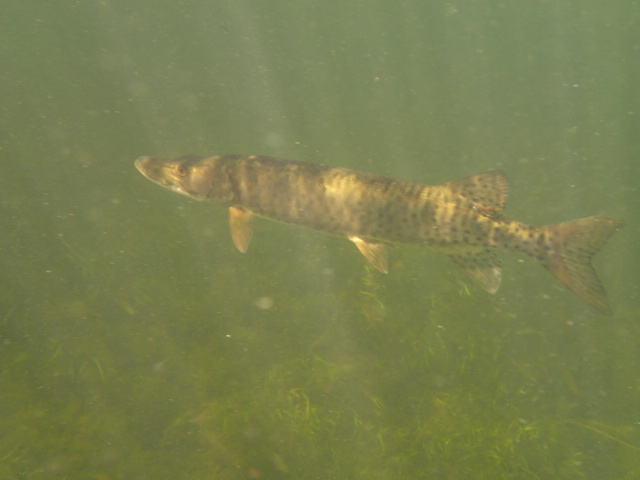 After an hour of exploring the backwaters of the creek, I turned towards shore and I saw a muskie following about 6 feet behind me. When I turned toward it, the muskie did not move away. This 3 foot fish exuded a “presence”, and I wasn’t sure I was welcome in its domain. At one point it faced directly towards me, and I hoped that I didn’t have any resemblance to a large muskrat. For 3 days I could see those eyes staring back at me. They were the eyes of a living being completely wild and free – exuding the immenseness of nature.
After an hour of exploring the backwaters of the creek, I turned towards shore and I saw a muskie following about 6 feet behind me. When I turned toward it, the muskie did not move away. This 3 foot fish exuded a “presence”, and I wasn’t sure I was welcome in its domain. At one point it faced directly towards me, and I hoped that I didn’t have any resemblance to a large muskrat. For 3 days I could see those eyes staring back at me. They were the eyes of a living being completely wild and free – exuding the immenseness of nature.
As I swam away, I wondered if this was the same muskie that was stranded in the creek before freeze-up, and we returned it to Lake Minnetonka. It makes a good story, but it probably wasn’t…
“Birds and nature, in general, provide me with such spiritual joy and a sense of connection that it was only natural to feel the urgency of this latest environmental issue. It is a problem we humans created; it is a problem that we can and are obligated to fix”. – Judy Chucker
“Working to help bees keeps me sane in an insane world. It keeps me connected to others who care. It saves me from isolation and despair. It challenges me to grow and step out of my comfort zone. It gives me hope. And at this time in history I feel it is my moral duty to be hopeful and act on that hope. I can’t do everything at once, but I can do “something” at once—my “something” is working with others who care, to help bees. My heart is full and I am hopeful.” ~Patricia Hauser
At the end of December 2013, a group of us who were concerned about the disturbing reports we had heard about honey bee die-offs began meeting. Our group formally became known as Humming for Bees and we met at local libraries. This is our story.
We decided our focus would be to educate ourselves and others, bring change to one small city, and then expand to other cities. Since Patricia Houser and Jeff Dinsmore lived in Shorewood, MN, the group decided to target the town and try to pass an ordinance, banning the use of neonics. They went to countless meetings with city council members, the mayor, networking with people who were interested in helping. Patricia, Barbara Goodman-Fischtrom, Judy Chucker, Lu Harland, and Melissa Hochstetler spent countless hours “tabling” at special events and educating people about the problem. Jeff Dinsmore and others spent hours making “Bee Safe Yard” signs. The yellow signs have popped up in a number neighborhoods.
All of this work, has made a difference. Last month, on July 28, 2014, the Shorewood City Hall passed, “A Resolution Endorsing ‘bee-Safe’ Policies and Procedures”.
Below is an excerpt of an article that appeared in the Star Tribune:
In the growing movement to better protect honey bees, Shorewood has become the first city in Minnesota — and, leaders say, the third city in the nation — to pass a policy encouraging the planting of bee-friendly flowers and restricting certain pesticides.
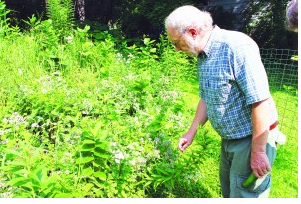
Jeff Dinsmore tends some of his “bee friendly” plants
http://sailor.mnsun.com/2014/08/08/shorewood-becomes-a-bee-friendly-city/
Becoming a beekeeper, I realized more and more, the huge importance of bees and pollinators in our environment and food production. With the current, and dominant methods for pesticide use in agriculture and even less controlled use in our urban/suburban environments, there must be a shift in practices to ensure our health and the vibrancy of our environment.
Jeff Dinsmore
With all of the research we were doing on honey bees and pesticides, Jeff Dinsmore took on the task of creating a website that was a resource for like-minded people. The website includes “bee-safe” nurseries, good plants for pollinators, the latest information on pesticides and honey bees. (Go to: www.hummingforbees.org/). Probably the best resource we found was the TED talk by Marla Spivak, from the U of MN Bee Lab (go to: www.ted.com/talks/marla_spivak_why_bees_are_disappearing).
“There is so much abuse going on environmentally and I’d ask myself, “Where do I begin? What can I do ? How can I make a difference??? The bees made it possible for me to simplify and focus on an issue of great importance, so I got involved”…Barbara Goodman Fischtrom
In the process of educating ourselves, we became aware of problems around systemic pesticides. Below are excerpts from an article that appeared in the League of Women Voters MN Newsletter by our leader, Patricia Houser:
(http://www.lwvsouthtonka.org/uploads/8/4/7/2/8472689/ask_b4_u_buy.pdf)
…In the early 90’s a new family of insecticides, neonicotinoids, was registered with the EPA. Many people are now referring to them as “neonics.”
“Neonics” have become both ubiquitous and implicated as one of the key factors of CCD or Colony Collapse Disorder of honey bees world wide. They’ve also been linked to harming native bees, other beneficial insects and pollinators. In addition, there is growing concern for birds and aquatic life in relation to this family of insecticides.”
One thing we learned is that most agricultural seeds, including corn, soybeans, and sunflowers are treated with neonics. Alternately, most bedding plants and perennials supplied from commercial nurseries are sprayed with neonics to survive shipment and assure good presentation at retailers. Neonics are a systemic pesticide. As the plant grows, its roots, stems, leaves, and flowers hold the insecticide and the plant remains toxic (for a long period of time) to any insect that uses the plant, pollinators included. So if you want to purchase a plant that pollinators would visit, there is a good chance that the plant was treated with a neonic. “Humming for Bees” decided to query retailers and nurseries, and express the need to purchase neonic-free plants.
Patricia’s article continues:
There are nurseries and garden centers that have either been pesticide free from the beginning or are now talking with their growers and suppliers about the history of the plants they are buying. This is not easy and in some cases impossible. It’s hardest to determine the history of bulbs and cutting-grown plants because they come from all over the world and often have gone through multiple distributors before arriving in the U.S.
Some venders are refusing to buy plants (annuals and perennials) that have been treated with neonics. Some are planting their own organic seeds and refusing to use any neonics on them during the growing process. Many are still accepting and selling plants that have been treated with neonics and in some cases are still using neonics on their own plants. This is why you should “Ask B4 U buy”. Most nurseries are concerned about this serious issue.
Once I saw the seriousness of the situation it was obvious that something needed to be done and so Humming for Bees will be on my agenda for a while now. It’s been inspiring to see what can be done by ordinary citizens. Lucia Harland
Unfortunately, the “neonic” problem does not appear to have a fairytale ending. Monsanto and Bayer Corporation are probably readying for the roll-out of the next generation of pesticide. Judy Chucker, another “buzzer”, researched the “neonic” problem in relation to birds and other living things. Below is some of her material that appeared in a local Audubon publication (http://audubonchapterofminneapolis.org/wpaudubon/wp-content/uploads/2009/08/MayJune2014.pdf:)
“The neonic problem is much bigger than the plight of the honey bee–a complex issue not limited to pesticides–upon which a third of our food depends. Historically, birds have not faired well with pesticides. This new class of pesticides is no different. Had any bird the size of a blue jay, grabbed just one neonic-coated kernel of corn, or scratched the dirt to uncover a kernel, that would have been its last supper. While smaller seeds such as wheat treated with the neonicotinoid, Imidacloprid , may also kill a bird. In addition, it takes only 1/10th of a corn kernel to interfere with reproduction during the egg-laying season by any of the neonicotinoids.
The risks posed to birds by neonicotinoids are not confined to consumption of coated seeds or the parts of the plant that grow from those seeds. Due to neonicotinoid persistence and mobility, the risks extend to aquatic and terrestrial invertebrates, and other wildlife: Neonicotinoids are killing the invertebrates upon which birds depend. Already, scientists such as University of Saskatchewan’s Assistant Professor Christy Morrissey, are discovering surface and
groundwater contamination worldwide at levels that exceed those necessary to kill many aquatic invertebrates. With a report due in 2016, Morrissey’s work, suggests that prairie wetlands surrounded by croplands such as corn and soybeans have higher concentrations of neonicotinoids. Mineau has suggested elsewhere that grassland birds are in decline more from pesticide use than from habitat loss.
For those of us who feed birds, an investigation into birdseed is still underway. My calls to a popular bird feed store (with 300 stores nationwide) alerted a concerned manager to the potential problem. Over several weeks she attempted to find the answer to this question, but in the end could only offer her confidence in the individual responsible for the company’s seed quality.”
For me, it wasn’t so much about “saving the bees”, as it was about changing our attitudes towards how we treat the Earth. I was continually inspired by the commitment of our bee group and thankful to be around people who worked so hard to make a difference.
Lawrence Wade
A Snapping Turtle in a Bit of a Predicament
by Linnea Palmstrom. Linnea will be a Freshman at UCSB. Previously, she contributed another story about rescuing some turkey eggs from flooded Nine Mile Creek. Go to: www.oldnaturalist.com/flood-rescue-a-guardians-tale/
It was just another day going to Nine Mile Creek by Edina High School. I had enjoyed walking around the wetlands area by the lower fields and it was getting late, but I decided to make one last stop to a man-made pond to look for a mallard mother and her ducklings. When I got there, I discovered that a snapping turtle had gotten stuck in a grate covering the entrance to a drainage pipe. The poor turtle was hanging upside down with its bumpy shell wedged firmly between the bars of the grate. At first I wasn’t sure if it was alive. As I walked closer I saw its head move up out of the water, and I knew it could still be saved. I wanted to help it and went home to get some leather gloves to make sure that I had some protection. When I got back, the turtle hadn’t moved. I grabbed the back end of its shell to pull it up and out of the grate; however, the turtle didn’t want to help me. It kept sticking its front feet out to stop me from pulling it away from the bars. It would also kick my hands with its hind legs and threaten to bite me – thankfully its position and the bars of the grate stopped its long neck from reaching me. After a couple of minutes, I finally freed the turtle. I slid it next to the water and it quickly swam away. Though the snapping turtle was irritated at me for helping it out, in the end, I think it was happy that I did.
Why did the Snapper Cross the Road?
By Steve Casper, Eden Prairie, MN
The other night around midnight I was driving in Edina near Minnehaha Creek when I saw a car pulled over in a strange part of the road. As I drove by I could see in the headlights that a young man was trying to herd a big snapping turtle back to the creek. I pulled over and gave him a hand- it wasn’t easy. If you pick up a snapper by the shell, it may not be able to bite, but it can still get you with its sharp claws!
Anyway as we got him back, the fellow said this was the second time that day he’s moved her. He said he’ll be driving down the same street again in the morning and he hoped not to see a dead turtle. I said I’d be coming by again the next morning, too. Well it’s been about 3 weeks now, and no dead turtles on that stretch of road- always glad to see that!
Blessed By My New Friend, A Silver Maple
By a teacher from the Hopkins School District
On a particularly emotional day, I was sitting outside on my patio soaking up the sun and listening to the sounds of nature. After awhile, I focused my gaze on a silver maple tree that sits in my backyard. I was looking not directly at the tree, but beyond it. Suddenly, I could see the maple’s energy field, a yellow hue that outlined each branch. As soon as I started thinking about what I was seeing (rather than feeling it), the field would vanish. On and off for about an hour, I received this loving, accepting, and calming energy. My new friend, a maple, blessed me that afternoon. It said to me, “You are connected. You are not lost.” Before I went inside my home, I thanked my friend for the gift it gave me. Every day I go outside or see my friend from my window, I am filled with gratitude.
Eye to Eye with a Dragonfly
Amy Flatten, Project Get Outdoors
www.facebook.com/pages/Project-Get-Outdoors-Inc/137770441949
About a month ago, I was offered the option to catch and identify dragonflies, by Juliane, a dragonfly enthusiast. In actuality, it was an offer to run around with a large bug net chasing dragonflies. They were zooming past with the utmost speed and were true aerial acrobats. It was remarkable to watch them! Upon the first successful catch, Juliane demonstrated how to very carefully remove it from the net by grasping its wings. In doing this, we were able to get a closer look at the insect. I appreciated her care for such a small creature! As I stared at it, the dragonfly unblinkingly stared right back. How large the world must seem to such a small creature as this! But what a large predator it would be, if I were the size of a fly – yikes! We proceeded to look at how close the eyes were to each other, any unique markings on its sides, tail and face. She would lead me to a picture in her key that would match. Yes, I will remember my one-on-one time with an experienced dragonfly enthusiast, but I will also never forget carefully holding these wild insects and wonder what’s on their mind as they are happily released.
When was the last time you really looked at an insect? Maybe it’s time to have your own insect encounter and delve into the six-legged world!
I Saved A life Today!
Marian Eisner, Bloomington, MN.
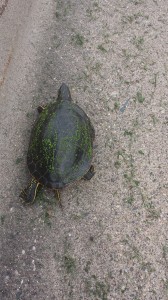 I was walking around Normandale Lake this afternoon when I got to the boat launch area, I saw this turtle trying to cross a two way road with a car exiting the boat launch onto the road. I stopped traffic, and the turtle turned around and headed back toward the lake. It was still slowly walking along the boat launch road, and I followed it. I kept saying, “Come on turtle” and each time I did it started to walk faster. When it got to the curb, I gave it a little nudge, and it climbed onto the curb and out to the lake.
I was walking around Normandale Lake this afternoon when I got to the boat launch area, I saw this turtle trying to cross a two way road with a car exiting the boat launch onto the road. I stopped traffic, and the turtle turned around and headed back toward the lake. It was still slowly walking along the boat launch road, and I followed it. I kept saying, “Come on turtle” and each time I did it started to walk faster. When it got to the curb, I gave it a little nudge, and it climbed onto the curb and out to the lake.
I saved a life today -it feels great!
An amazing afternoon with a special little old kestrel at Richardson Nature Center.
Pauline Bold, Naturalist, Three Rivers Park District, Richardson Nature Center
March 12, 2013 – The kestrel and I sat in front of the windowed wall in our wildlife viewing room at the nature center for 45 minutes (his favorite place in the world). There were a lot of birds and squirrels to watch. A goofy turkey watched us with his beak right up against the window. The kestrel spent 15 minutes preening, making himself very beautiful. He spread his wings and tail, and “talked” a bit. Scratched his head and ended up with a rakish feather hanging over his eye – made me laugh. He was a happy little boy that day.
March 13, 2013 – End of story…yesterday I got to look into the eyes and soul of a special little bird. Today his soul has been set free. After 15 years of being an excellent ambassador for his species, and helping us to educate thousands upon thousands of people, our kestrel’s spirit is now free to soar. He will be greatly missed, but we were honored to share in his life.
Where Smart Birds Nest
Dewey Hassig – Dewey is a beekeeper in Minnetonka.
I won’t be canoeing this spring. My canoe is upside down on a rack on the back of my garage, and a Cardinal has made it’s nest on the seat. At least that Cardinal has a dry spot to nest.” (Editor Note. Dewey sent this to me in May and I saw him a month later and he said that the Cardinal abandoned the nest with one egg in it and re-nested on the opposite seat).
I am the dark but glistening water
I am the hard and ancient rock beneath you
I am the trees and bushes that rustle in the wind
I am the distance with so many wonders
I am the clouds that cover the sun.
I am the flowers that are bright among the rest.
I am the stumps that you pass with no looks.
I am me, admiring all these things,
Not behind a TV, or a screen,
but within my own eyes
Feeling it in my soul
As all this beauty, adventure, and harmony
Stands so tall and powerful among me.
Bryn Pursey
Teach Me
Teach me to grow and strengthen everyday
Like your wooded open arms
Teach me to nurture and enjoy
Teach me
Teach me to breathe, absorb smells of fresh pine and wet new soil.
Teach me to be a family, living together in harmony
Teach me mother nature how to be.
Teach me to blossom and bloom
Teach me your songs of thunder and wind
Teach me how to be a light as you carry the sun on your shoulders
Teach me calm and serenity
Teach me mother nature how to be
Meg Jenny
Teach Me
Lyrics by Meg Jenny
Arrangement and Music by Edward Jones
Vocals: Edward Jones and Larry Wade
Listen:
A soft summer wind blows
The trees rustle to say hello
The leaves dance wildly
Clinging to the branches
A leaf or two falls off into the breeze
And scrapes the ground softly with ease.
Lucy Smith
I am the rocks we sit upon
I am the cliff that hangs over the lake
I am the darkness that covers the beauty
I am the man who watches the trees.
George Dunkelberger
I am the mist hanging in the midsummer’s air `
I am the breeze refreshing, yet cold and stinging
I am the shifting boulders who stand infallible and unequaled
I am the dove bringing good omens to the earth.
Alex Patridge
I am the wind on the great lake
I am the rocks jagged and sharp
I am the bees, birds and trees
I am the trees swaying like a mystical hare.
I am Wolf Ridge and Wolf Ridge is me.
Sam Driver
Stones are rocks and bountiful
They can be mountains or pebbles
Red, white, blue, green or brown
Rocks await to be found.
Some are bland, some are speckled, some are striped
Some so dark, they fade into the night.
Lucy Smith
Have you had an interaction or connection with a living thing that touched you? Don’t be shy! All stories will be celebrated.
Send me your stories and a photo. Try to limit your story to 2 paragraphs. If you don’t have a photo send your story and I’ll add one of my photos. If you want some help writing your story, I’ll work with you. Send your material to:
larrywade16@gmail.com
Your story will be posted at this website on August 1st . The last day to send a story will be July 28th.
Below is an example sent in by Dewey Hassig.
Where Smart Birds Nest
I won’t be canoeing this spring. My canoe is upside down on a rack on the back of my garage, and a Cardinal has made it’s nest on the seat. At least that Cardinal has a dry spot to nest.” (Editor Note. Dewey sent this to me in May and I saw him a month later and he said that the Cardinal abandoned the nest with one egg in it and re-nested on the opposite seat).
Fourteen teenagers face the wilds of the swollen Minnesota River and try to be true to their art and creativity.
I am drowning.
I slowly sink deeper into a dark abyss.
This weight getting heavier
Dragging me
Deeper and deeper into the depths.
The light shrinking;
Surroundings less identifiable.
I’m lost in my thoughts, scared. Alone.
I reach my hand up
Hoping
That someone will reach down and save me.
I’m still reaching.
I’m still hoping
I’m still drowning.
Carmen Erickson
Nature.
I see mosquitoes.
I touch my swollen mosquito bites.
I hear the buzzing of mosquitoes in my ear.
I feel angry.
Nature.
Damn these mosquitoes.
Going outside is alright.
Ha Ha, that’s funny.
– Lee Cygan
Mosquitoes
Burn it with fire, Drown it with water, Blast it with wind, Crush it with stone.
Foul creatures Born from evil, Blessed with poison, Death to it all Mosquitoes
Plague that must fall. – AJ Vue
Never expect something
As beautiful as nature
To stay the same.
Usually there are
Remarkable differences in
Every inch of space you observe.
– Carmen Erickson
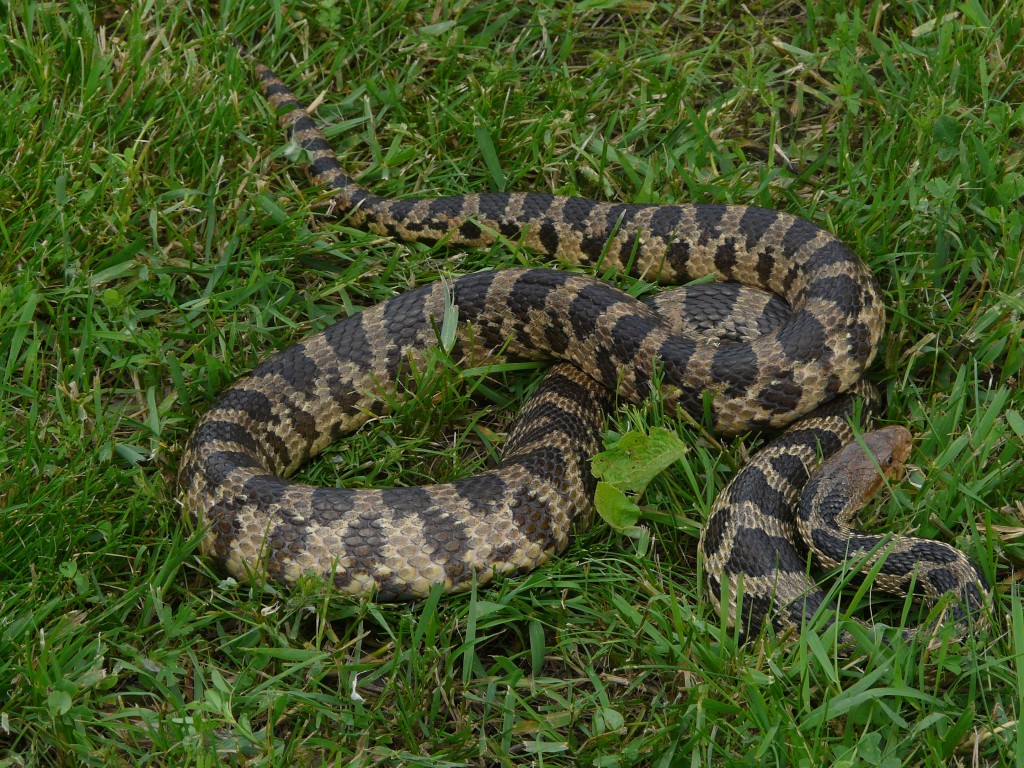
Fox Snake
Guadalupe came running down the stairs, her eyes wide with excitement. “ I saw the snake.” I told her there must have been a reason she was the only one to see it. As we walked back, she told me she was an Aztec dancer. From the Aztec calendar, one of her birth symbols is the snake. Because of her connection with snakes, Guadalupe can feel the vibrations of things and people around her.
Larry Wade
Where does Beauty hide?
In the green roots of
yarrow leaves, dug in
the wounds of history’s wars
Within the king’s mushrooms
his cap showered with pride
in the audience of his subjects.
And in the corpse of a
deer long lost cousin,
Whose remains will sunk
back to life’s beginnings.
Where does Beauty hide?
On the murky river of
no return, flowing and flowing
on an endless journey.
In Noah’s bark, the boat
of life that civilization clings
onto as it sways in the water
Where does Beauty hide?
In the lenses of Eyes
In the imagination of the Mind
In all living things.
– Xe Chang
Wind is blowing, clouds are bursting,
Water is dancing,
Waves are falling, Earth is screaming,
Flowers are singing,
Land is hiding,
Storms are coming.
– AJ Vue
Welcome to the city of long nights.
Vibrant yellow escorts
At a whistle’s beck and call.
Steamy kisses against bruised ankles.
Bright lights,
A bumblebee’s sting
In your greedy little irises,
Greasy fingers
And
Clouded thoughts
Foreign languages
Invade comfort zones.
GET OUT
Of my comfort zone,
Please.
– Roma Murphy
Last night I heard you sing to me.
Whispers echo through the roots of
the deep soil,
Making its way through the skimpy
branches of an aged tree.
I heard it jump through a vast
Body of cool blue water. The
Sweetness of your voice swarmed
Into my young ears,
Trickling into my deep core.
Last night I heard you sing.
– Ashley Brewer
We have been learning about Lakota culture, and it has inspired me to learn more about my culture and incorporate it into my art work. – Gabrielle Jackson
I near the edge of the wild
Unwanted, but crucial
Seen, yet invisible,
Loving, but feared
And know that I can change this.
-Sam Porter
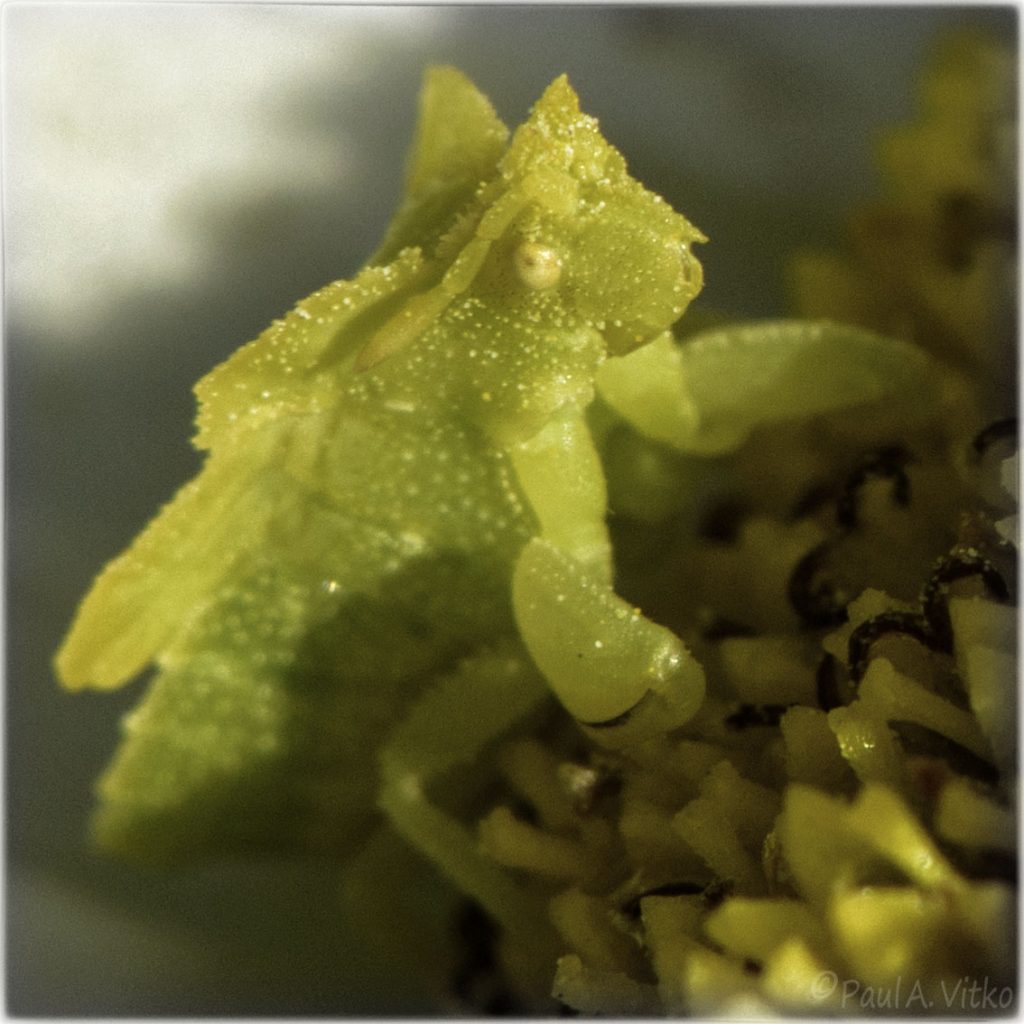
Ambush bug
Paul Vitko
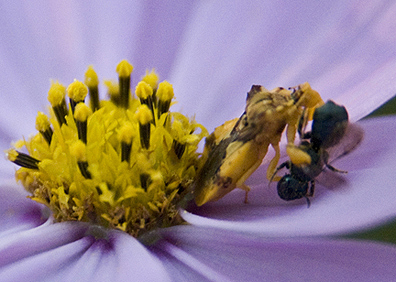
Ambush Bug
(Paul Vitko
“In the heart of Minnetonka you can find solitude and a connection between earth and sky, if you seek it”.
Photos and text by Dale Antonson
If you live in Minnetonka and have yet to experience the serenity of paddling along the first few miles of Minnehaha Creek, I would like to share with you a little about this treasure that flows right through the heart of our community.
Minnehaha Creek begins at the Gray’s Bay Dam on the east side of Lake Minnetonka. Here it begins its south-eastward journey 22 miles to the Mississippi River. The first 2.5 miles of the creek, from the headwaters to the canoe landing at the historic Burwell House, offer the floating visitor opportunities to observe nature from the quiet waters that flow through mostly undeveloped wetlands and forested landscapes.
Visiting is best between spring and summer, from the time the winter ice starts to melt in April to the warmer month of June. During this time,water’s flow is faster and the aquatic weeds won’t be an issue (later in the summer, paddling is impeded by both). A couple of hours are all that’s needed to escape into this serenity. I encourage you to take your time and paddle at a leisurely pace. As the Chinese philosopher and poet Lao Tzu wrote many years ago, “Nature does not hurry, yet everything is accomplished.”
Parking at the Gray’s Bay Dam is really limited so it’s a good idea to arrange for someone who can drop you off with your canoe or kayak and pick you up later at your final destination. A good map of the creek is available here: Minnehaha Creek Canoe map.pdf. If you plan on continuing beyond the canoe landing at the Burwell House, where the creek becomes faster and difficult to navigate for the novice, it will be important to be aware of the current flow rate of the water through the Gray’s Bay Dam during your visit. Water flow rates higher than 150 cubic feet per second are considered dangerous and the rapids should be avoided. The current flow rate of the creek can be found at: Gray’s Bay Dam Flow Rate
If you don’t have access to a canoe, The City of Minnetonka provides a canoe rental and shuttle service on weekends during May and June for 2 to 3-hour-long trips from the headwaters to the canoe landing at Hopkins Crossroads. You can access information on this service at: Minnetonka’s Canoe Minnehaha Creek. Participants register in advance and will meet the shuttle van at a reserved time at the ice arena behind Minnetonka City Hall at the ice arena. From there, a van will drop participants off at the headwaters with any necessary gear and pick them up later at the designated location for return to their vehicles.
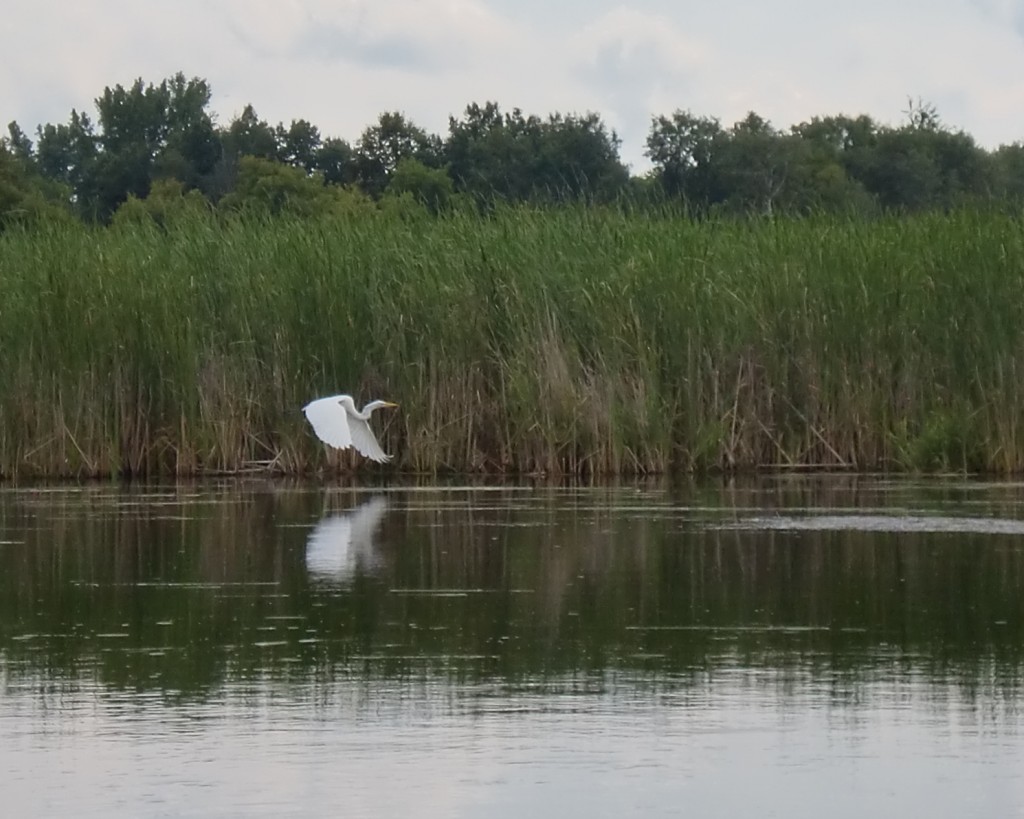
A beautiful egret plays “hide-and-go-seek” with those who paddle quietly and respect others’ privacy.
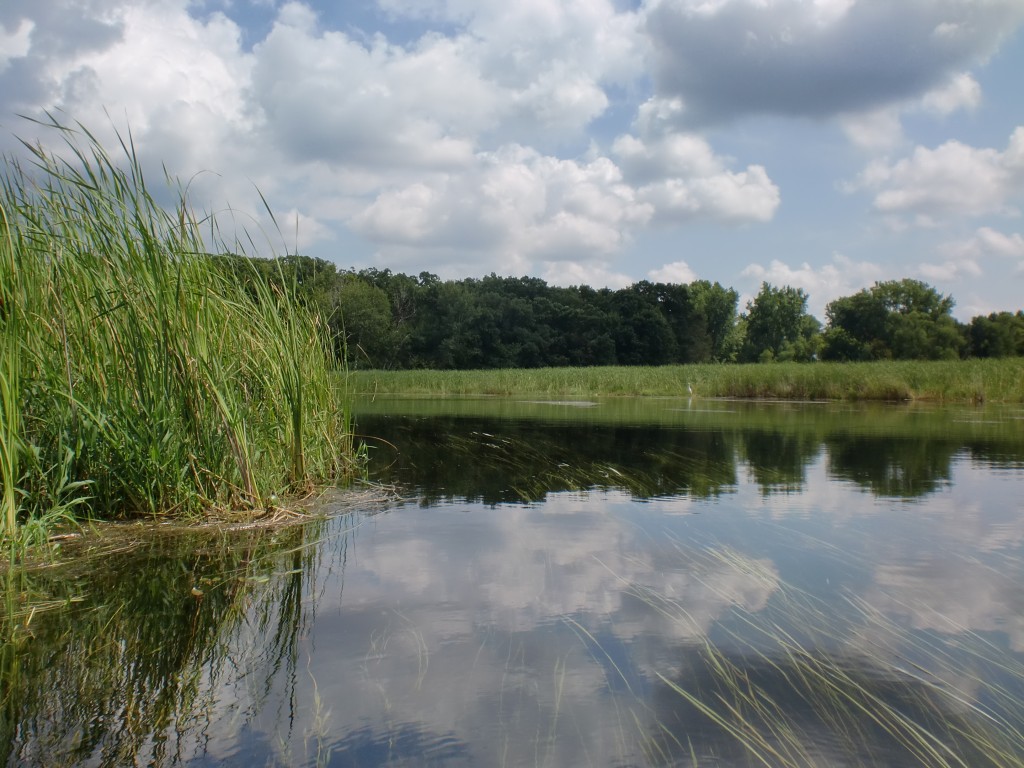
A sweeping bend in the creek, with the wide open sky and cattails, quickly gives way to the unexpected landing at Jidana Park.
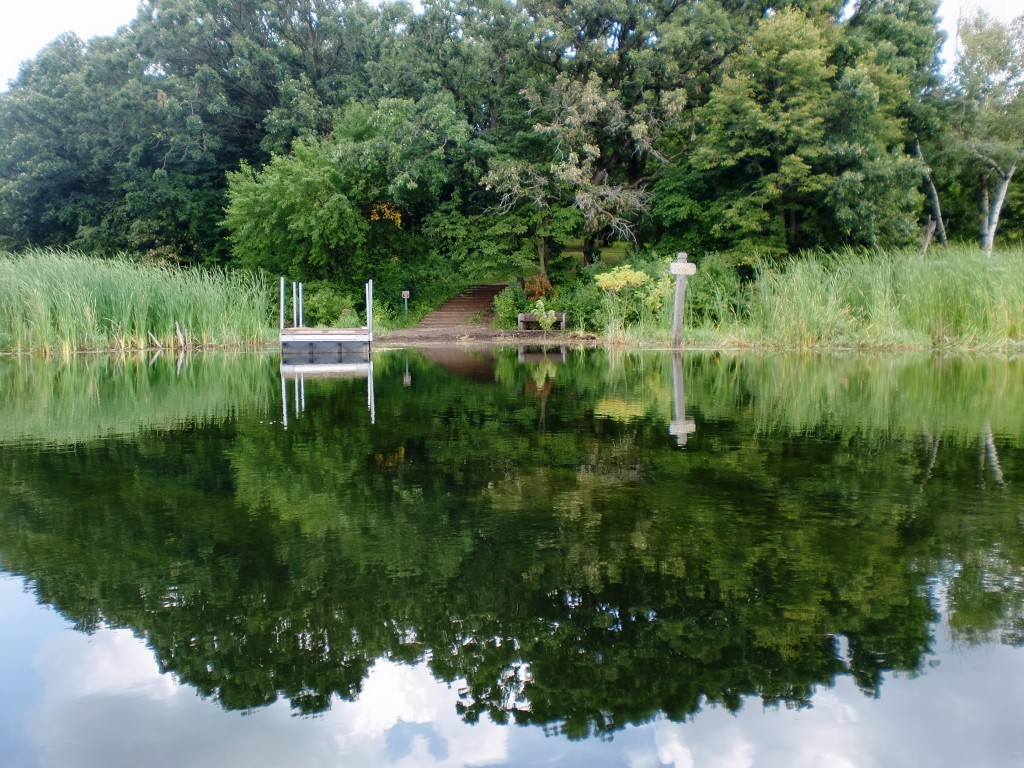
The Jidana Park canoe landing is the first of many along the creek. This gem of Oak Savanna offers a delightful park to explore and have a picnic.
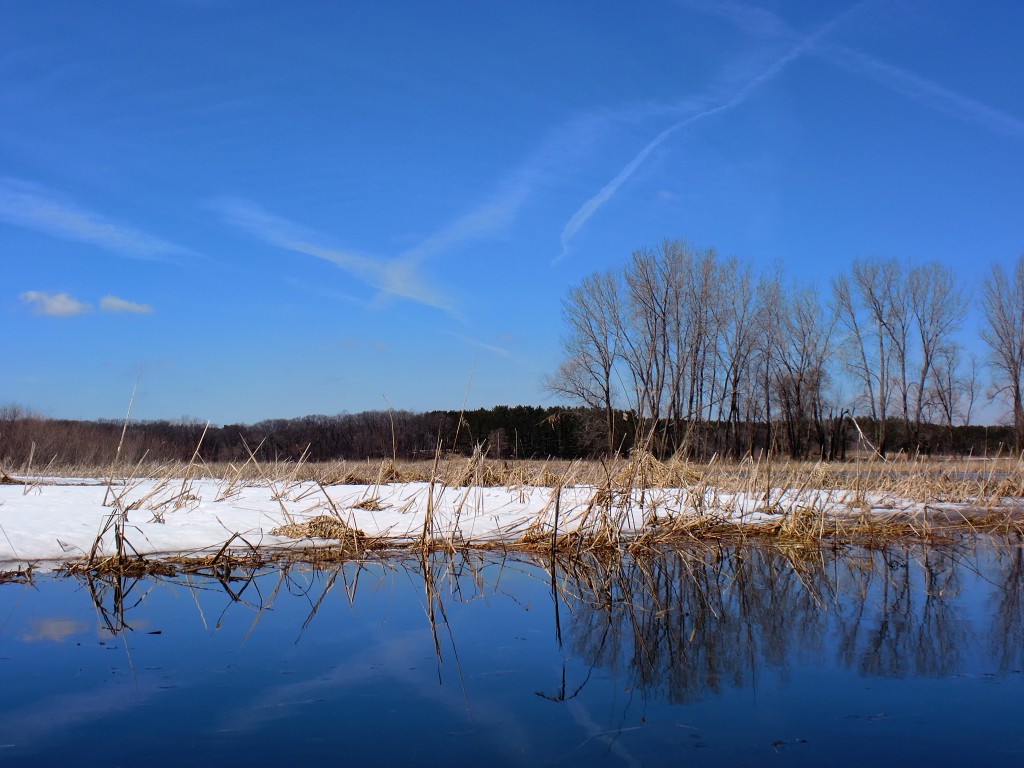
In the heart of Minnetonka you can find solitude and a connection between earth and sky, if you seek to find it.
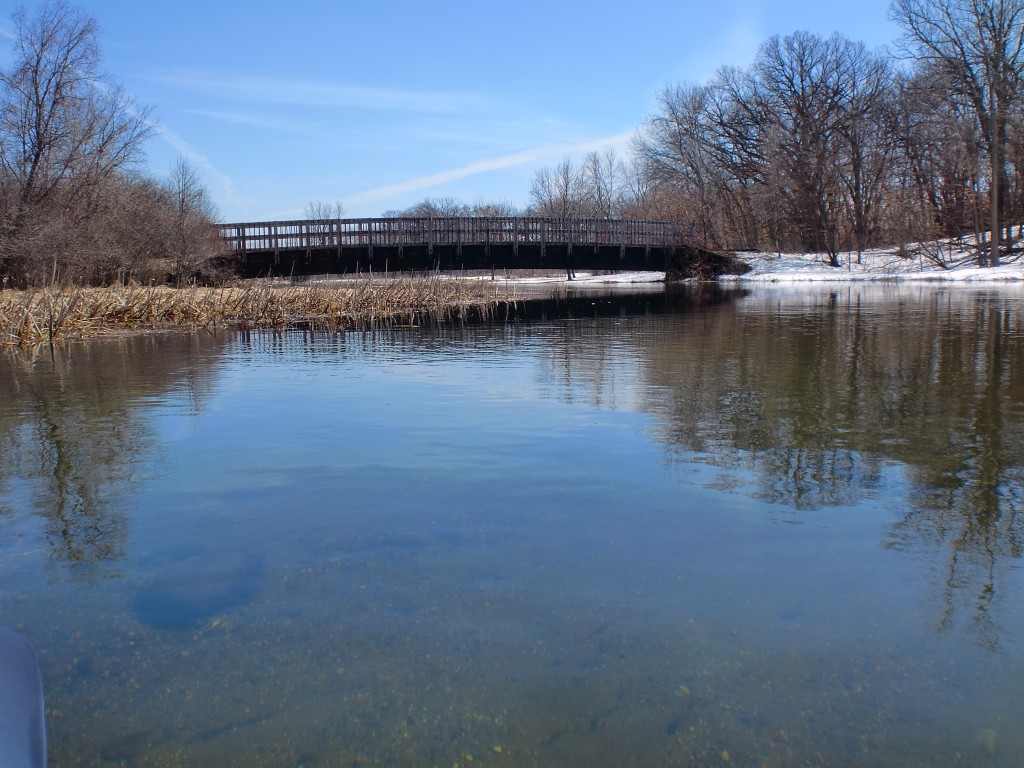
Around a couple more bends you come upon this pedestrian bridge. It’s in close proximity to another canoe landing located on the north side of the Minnetonka City Hall acreage.
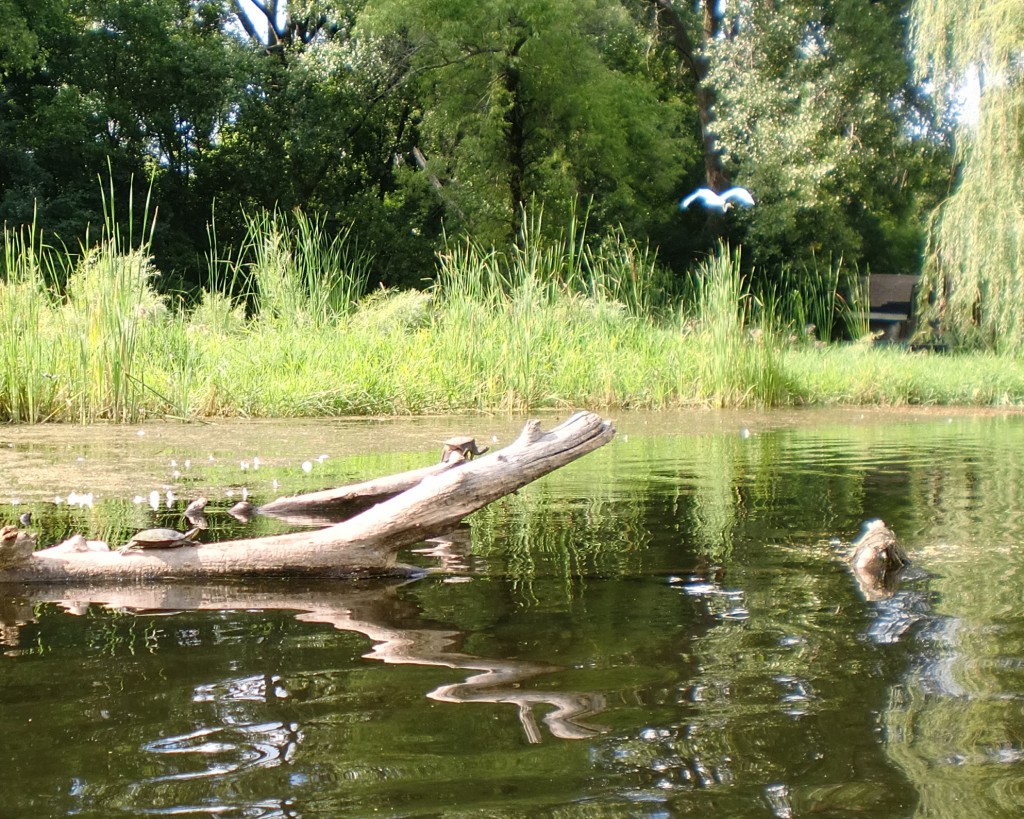
Can you see the wildlife community here?
A mud turtle, snapping turtle, egret and Canada goose delighting in the day.
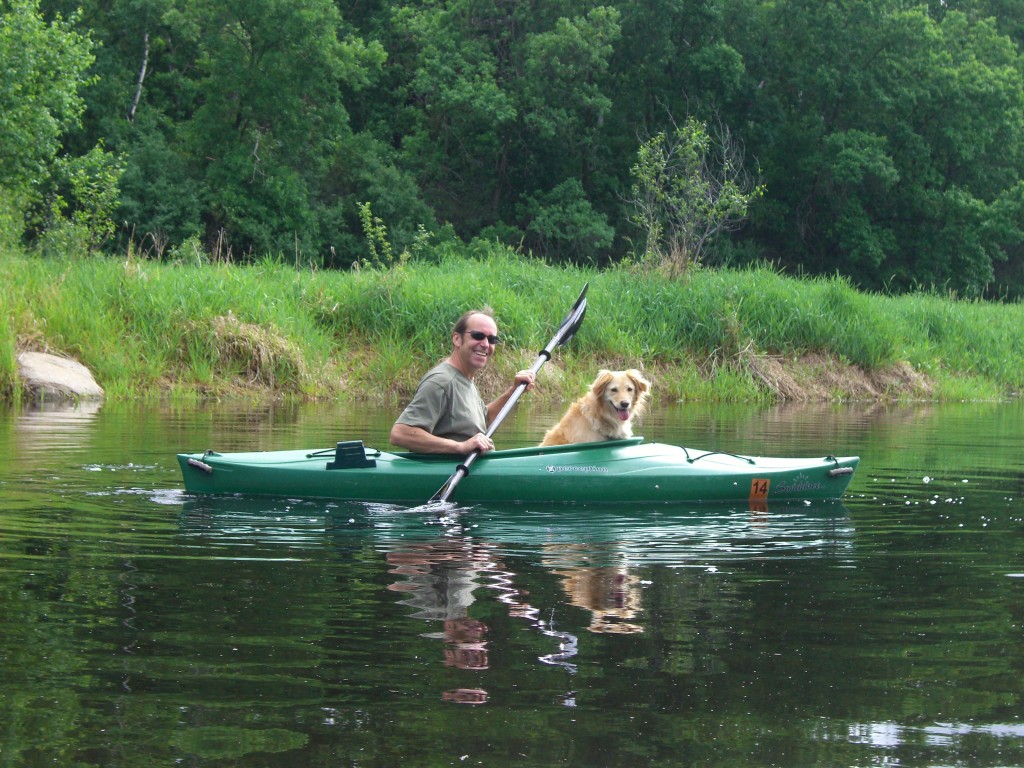
The author/photographer, along with his dog called “Jessie Joy the Happiness Consultant,” are doing something they love that connects them with nature.
Relax, slow down, float away and discover something new this spring at the headwaters of Minnehaha Creek. Many hidden treasures await you there.
If you’d like to see more of Dale Antonson’s nature photographs, you’re invited to his exhibit of nature scenes at the Off the Wall gallery at the Hopkins Center For The Arts, from May 13 through June 9, 2014. The show is titled This Garden We Live In.
(All photographs were taken by a Casio EX-Z90)
Reader, Dewey Hassig shared the following comment:
“I won’t be canoeing this spring. My canoe is upside down on a rack on the back of my garage, and a Cardinal has made it’s nest on the seat. At least that Cardinal has a dry spot to nest.”
We can not predict climate change (global warming) by studying local weather patterns.
Thanks to Dr. Lee Frelich, Director of the U. Minnesota Center for Forest Ecology for contributing the graphics and making editing suggestions.
Are you thinking what I am thinking? There is no global warming in Minnesota. After 50 days of sub-zero weather this winter, who wouldn’t be thinking this?
![]()
In the graph below, the light blue area (labeled “Trough”) shows the Arctic cold temperatures that much of the Eastern United states experienced this winter (2013 and 2014), while the West had above average temperatures (labeled “Ridge”) and parts of California experienced record warm temperatures.
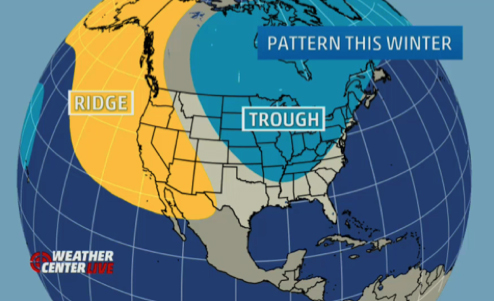
The reddish areas in the graphic below shows where temperatures were warmer than average in January, 2014. While purple shows locations where temperatures were colder than average. It doesn’t take a rocket scientist to notice that there is a lot more red (warmer temps) than there is purple (colder temps) on the graphic below. In fact, world-wide, it was the 4th warmest January in 134 years of record. On January 6, 2014 the high temperature in the Twin Cities was -12° F. On Jan 27th the high temperature was -6°F in the Twin Cities while the high in Nome, Alaska climbed to 51° F. We can not predict climate change (Global Warming) by studying local weather patterns. Climate change is a global phenomena and we need to look at the temperatures of the Earth as a whole.
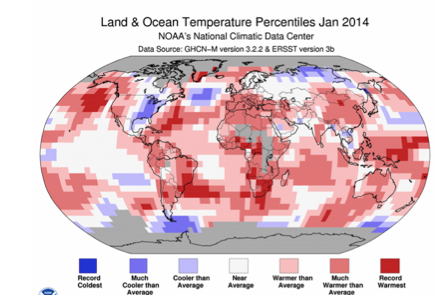 The graphic below shows temperature change over a 10,000 year period. For the last 5000 years the temperatures on the earth has been getting cooler. But roughly 50 years ago the temperatures began to spike (red line). The graph uses the term temperature anomaly which is the difference between the long term average temperature and the temperature of a given year. So if the temperature was colder than the long-term average, the trend line is below the zero point on the left axis, and if the warmer than the long-term average, the trend line is above the zero.
The graphic below shows temperature change over a 10,000 year period. For the last 5000 years the temperatures on the earth has been getting cooler. But roughly 50 years ago the temperatures began to spike (red line). The graph uses the term temperature anomaly which is the difference between the long term average temperature and the temperature of a given year. So if the temperature was colder than the long-term average, the trend line is below the zero point on the left axis, and if the warmer than the long-term average, the trend line is above the zero.
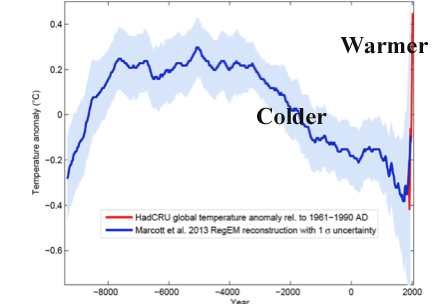 Does anyone remember March 2012? The entire month was warm and the earliest 80°F temperature ever recorded was on March 17th. Was this a sign of global warming (trick question)? Answer: you can not predict global climate change based upon local weather.
Does anyone remember March 2012? The entire month was warm and the earliest 80°F temperature ever recorded was on March 17th. Was this a sign of global warming (trick question)? Answer: you can not predict global climate change based upon local weather.
In March of 2012, the jet stream was positioned so that there was record heat East of the Rockies and cold to the west of the Rockies (graphic on the right).
If nothing changes and global warming continues unabated, Dr. Frelich predicts that Minnesota’s summer climate will be more like Kansas and Nebraska by the end of the century. As a result, there could be a 300 mile northward range shifts of habitat (graphic below).
If global warming goes unchecked, there will be winners and losers. Tree species in the Boreal community will disappear and moose and lynx will no longer be found in Minnesota.
New species of trees will take the boreal community’s place. There will be more deer, wolves, and bobcats.
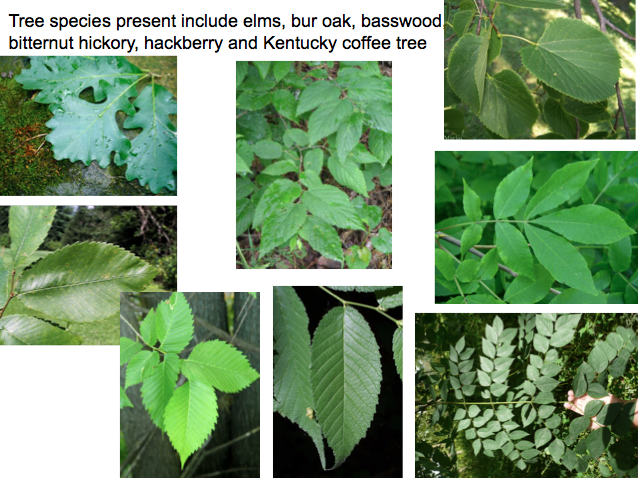
This is not the kind of legacy that we want to leave our children and grandchildren. There is a lot that we can all do individually. If you are compelled to make a change in your life style and want to be part of the solution, go to the following links:
10 personal solutions to global warming:
http://www.ucsusa.org/global_warming/what_you_can_do/#Take_Personal_Action
10 solutions to climate change:
http://www.scientificamerican.com/article/10-solutions-for-climate-change/